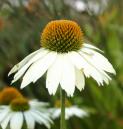A phenol, C10H13OH, obtained by fractional distillation of oils from Thymus vulgaris, Carum ajowan, and Monarda punctata. That portion coming over at 392°F. (260°C.) is separately collected and subjected to freezing, when thymol crystallizes out; or by distilling off a greater part of the light oils or hydrocarbons and obtaining the thymol from the remaining heavier liquid by the use of caustic soda and HCl.
DESCRIPTION.—Small, colorless scales or large, translucent crystals of the hexagonal system having a thyme-like odor arid pungent taste, somewhat caustic to the lips. It melts at about 50°C. (122°F.), but does not crystallize again until a much lower temperature is reached. Sparingly soluble in water (1:1200), but dissolves in less than its own weight of alcohol, ether, or chloroform. The crystals have a specific gravity of 1.069, but the melted liquid is lighter than water. Chemically, thymol is considered as isopropyl-meta-cresol (C6H3.CH3.OH.C3H7), and is closely related to carvacrol, which is regarded as isopropyl-ortho-cresol. the two differing in the relative position of the hydroxyl group. When 2 Gm. are volatilized on waterbath not more than 0.05 per cent. of residue should remain. It should melt from 48° to 51°C.
As a solid it is heavier than water but when liquefied by fusion is lighter than water.
ACTION AND USES.—Stimulant and powerful antiseptic, generally applied externally in ointment or lotion, or in a spray, considered almost as a specific in Hookworm disease. Aristol.—A name applied to thymol iodide (q.v.). Internal dose: 1 to 2 gr. (0.065 to 0.13 Gm.).

